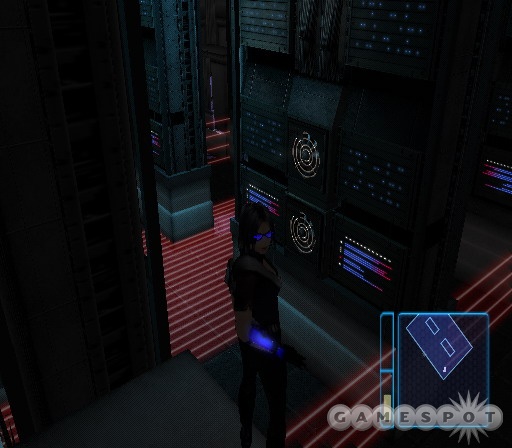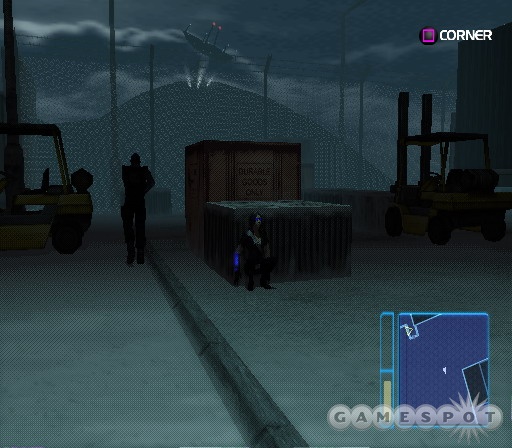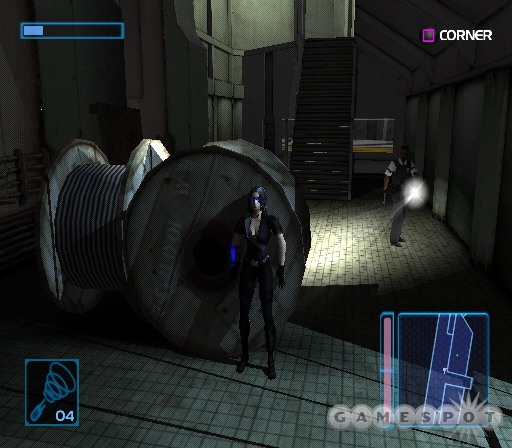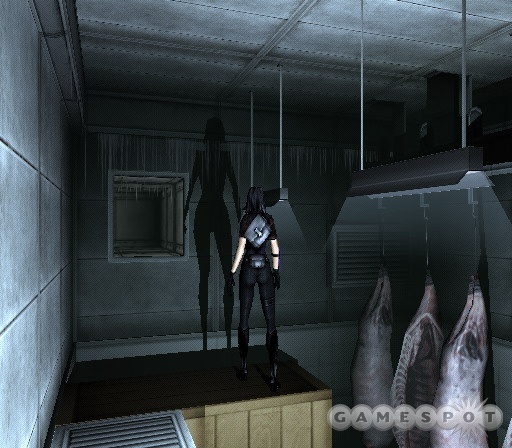Stolen Designer Diary #2
Blue52 art director Jaid Mindang talks about Stolen's art style and the problem with Hollywood scriptwriters, among other things.
First spotted as a mention on blue52's Web site in August 2003, Stolen is a stealth-based action game that's scheduled for release on the PC, the PlayStation 2, and the Xbox in March. Details of the game's storyline, which will see you assuming the role of a professional thief named Anya Romanov, are still being kept under wraps, but that doesn't prevent art director Jaid Mindang talking about Hollywood scriptwriters, pizza boxes, Dizzie Gillespie, and Stolen's art style in our second Stolen designer diary.
The Stolen Renaissance
By Jaid Mindang
Art Director, Blue52

I'm in charge of the art department, whether that's across several teams, as has been the case in our past, or just the one team, as we are currently. I was traditionally trained in animation, including drawn cell animation, Claymation, and puppet animation, although ironically, not computer animation. Little was I to know at the time that my career was to be more influenced by the time I spent pumping coins into the R-type cabinet in our student union bar than by the time I spent slaving over a light box or fashioning psychotic animals from clay. Animation would still be my discipline of choice, but for the fact that I've stepped aside to make way for the youngbloods on the team. That's what I tell everyone, and the fact that the last time I used a 3D package in anger was when 3D Studio R4 was current and ran in DOS has absolutely nothing to do with it. If you say otherwise, you're fired.
Well normally, of course, an art director would oversee the creation of a new and unique art style for the game and make sure that that style is adequately conveyed to the team creating the art assets. The art director would also police the creation of those assets with jackboots and a riding crop. Thankfully for me, most of that was well in hand by the time I got involved on the project, so for Stolen it was a "simple" case of trying to instill good working practices, such as regular art team meetings and documentary evidence of decisions made and problems solved, so that even during the development process we could learn from our own mistakes. I say "simple," but perhaps a more accurate turn of phrase would be "nigh on impossible." Nonetheless, the art style of the game is generally impeccable, consistent, and (eventually) even economical, in order to run on the PS2. I've even been inclined to ignore a few of the tackier touches, such as a row of portraits in one room with most of the art team's faces on them. It has been a fact of Stolen for a couple of years that I myself have been cast as one of the fat, lazy, doughnut-munching guards that you encounter initially. I'm sure this is in no small part due to the enjoyment this must continue to give the team when testing the combat system.

On Stolen, the art style has progressed in an unusual way since development started. Normally, the art style on a project develops as the team finds its feet and gets better at what it's doing as a cohesive unit. At blue52 we try to allow for that and factor it in. I don't believe it's realistic to expect a team to churn out its best stuff the first time, nor then would it be wise to restrict the team to delivering work only matching the quality of its first tentative efforts for the remaining duration of the project. However, that's never really actually been an issue with Stolen. Initially it started as quite a cartoony-looking game, with bright colors and hand-painted looking textures, then quickly underwent a renaissance once the design started taking shape and we realized that the target market would expect and appreciate a more realistic and immersive environment in order to maintain the sense of tension required for a stealth action game. However, since the demands on the underlying technology driving the real-time lighting and shadowing have been so high, the technology was a fair way behind the art production for some considerable time, giving the art team ample time to hone and refine the style of Stolen well in advance of our engine being able to deliver that look at a reasonable frame rate on a PS2.
Later though, the tech caught up and various nice, and even unexpected, effects like bloom filters, specular textures, and camera depth-of-field effects were made available to the salivating artists. What had then been intended to look like a stylized form of realism has actually exceeded that in many ways and we have had the game described as "ultrarealistic." I'm not entirely sure that this is an accurate description, although I note in an entirely conceited way as befitting my job description, that our game is more realistic looking than some others that have boasted "ultrarealism" from the get-go. I've even heard it bandied around on some of the Web forums that Stolen was a tech demo that turned into a game. Perhaps an easy mistake to make given that the art has looked like this for a long time now (for anyone who has never worked in development in their lives before). If only it were as easy as taking some neat-looking graphics and slotting gameplay in behind it. The art is the easy bit--I just badger our poor lead artist and give him some ham-fisted scribbles on sticky notepaper and, hey, presto! Nice art arrives a little while later. See? My genius is wasted here. I should work in advertising.

I've also been trying to make some sense of our plotline, which had historically suffered in the early days from the misguided assumption that hiring Hollywood scriptwriters to "big up" the production values of the storyline is a clever thing to do. That is, it may well have been if we'd been either developing a point-and-click adventure or if the scriptwriters in question had been allowed to see, nay, "play" the game in question while brainstorming the narrative thread that would string the whole thing together. Unfortunately, neither was the case here, and as an example of the madness that ensued, the art team received a script for a real-time cutscene showing a short conversation between two characters that just happens to take place in a crowded stadium during the Super Bowl, for no other reason than it was "visually interesting." At that point we realized that there was a gulf of understanding lacking between film production and the comparatively meager means of games developers and the inhibiting factor of real-time 3D graphics on games consoles. Modeling and animating a crowd of 20,000-plus people all cheering and waving as a backdrop to a 20-second sequence where a couple of lines of dialogue are delivered is not exactly cost-effective development. That could quite easily have prevented me from buying another ivory backscratcher if I hadn't stepped in.

In the end, in order to deliver a plotline that motivates but doesn't confuse, we've ended up with a 10-to-1 ratio of storyline cut to storyline remaining. What we have now is a leaner and more refined storyline with plenty of "latent backstory" ready to call upon or refer to in a sequel. I tend to think that many players will watch the full-motion videos and real-time cutscenes once for the first time and then forever after skip them impatiently in order to get on with the interactive bits. I know I do just that in most games I play, unless I am trying to eat my breakfast/lunch/supper at the same time, in which case these interludes of noninteractivity provide an opportunity to try and cram my mouth with enough food as to last me until the next cutscene. The need for sleep, sustenance, and toilet breaks is a bothersome interruption when you're really getting into a game. It's a wonder I don't have cheeks like Dizzie Gillespie. Thank goodness it's perfectly acceptable within the development community not to wash for weeks and to live among an ever-growing pile of pizza boxes.
Having just noticed my word count, may I hastily summarize by offering this thought: I believe sincerely that Stolen will be the type of game that players will get so immersed in that after playing it they will require further immersion in some kind of disinfectant before rejoining society. Would I lie to you?
Got a news tip or want to contact us directly? Email news@gamespot.com
Join the conversation